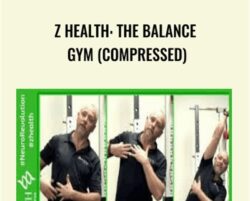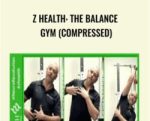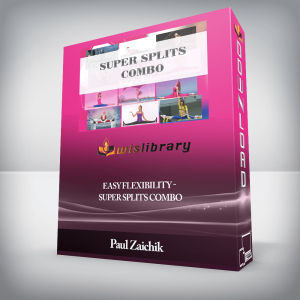Hi. I’m Dr. Eric Cobb, creator of Z-Health Performance. Today, we’re going to show you how to use a sixty-second exercise to massively improve your balance and movement by targeting one of the most important systems in your brain, your inner ear.You may have seen my video called Neurology 101, and in that video we cover really what I consider to be the most important concepts about the brain and the human nervous system. We tell people that it works really with three primary needs.We have input. We get information from our environment, from our body, that’s the input part. We then have the interpretation decision part that occurs in the brain. Then we eventually have an output, and that’s usually called movement so we can impact the world.Now everything that we do in Z-Health is based around this idea that we need to have high-quality input, we have to have great interpretation in the brain, and we need to have high-quality output as well.Today, what we’re talking about is one of the most important input systems into your brain from your vestibular system. If you’ve heard me talk about what we call the pillars of fitness, those are see well, balance well, and move well. Today, we’re focused on that second pillar called balancing well.Your vestibular system is what we call your onboard balance system. A lot of people refer to it as your inner ear, and what I want you to remember is that you have an inner ear on the right side, you have an inner ear on the left side, because you have two ears so you have two inner ears, and on each side you have five receptors. All right? Five receptors.Today, we’re going to be talking about six of them, three on the right, three on the left. The receptors that we’re talking about are called semi-circular canals. Now I’m not going to get into the anatomy of this stuff because it’s relatively deep, but all that you really need to understand for today’s purposes, to improve your balance and your movement, is that these canals deal with head motion and keeping your eyes oriented on a target.If they are dysfunctional, you’re going to have major problems. People that have canal issues very often have vertigo or other big dizziness issues, but lots of people with mild canal issues that aren’t getting dizzy still move poorly.Get Z Health: The Balance Gym (Compressed) – Dr. Eric Cobb , Only Price $27One of the things that we do a lot in Z-Health is we evaluate these canals. We show you exercises to train them, to improve them, and that’s what we’re going to focus on today. Today, again, we’re focusing on input from your inner ear. The exercise I’m going to show you is actually called a walking VOR.Now VOR stands for vestibulo-ocular reflex. One of the most important thing that these canals do is they keep your eyes steady when your head is in motion, so think about that, keeping your eyes steady while your head is in motion. We tell people that if your VOR is broken, your visual field will look like one of those 1980s home video camera movies where everyone is getting sick going, “Ah, I don’t want to watch the dog anymore.”If your VOR is a problem, it’s going to disturb your gaze a little bit.We have a lot of different exercises that we teach, but the one I’m going to show you is relatively advanced but we’re going to follow the basic Z-Health protocol. What I mean by that is that we’re going to test something in your body and then we’re going to do the exercise, and then we’re going to retest the same thing and see if you improve.If you improve, awesome, you can keep doing the drill. If you don’t improve, it may mean that you don’t need it or it’s too challenging for you.We’re going to start off with some basic assessment. For myself, I’m going to test some ranges of motion. One of the things I like to always do for myself is to do what I call a scarecrow. My arms are up and then I’m just going to rotate my arms down and in, and I’m getting an idea of how far my arm moves and the relative level of comfort. Today, my right shoulder feels a little stickier than my left. I’m going to make sure that I warm that up a few times, get an idea of how much I’m moving. If you want to do something else, you can do a toe touch, you can do a full body rotation, you could test your shoulder ranges of motion like this. It really doesn’t matter to me what you choose, but I want you to choose a movement. I want you to perform that movement maybe ten, fifteen times to warm it up, and then we’re going to do the exercise.Now the exercise is very simple-looking, but it may be too challenging for you. If you have had any kind of inner-ear issues, you get dizzy regularly, anything like that, I do not want you to do the exercise as I’m demonstrating it. I want you to do it in a simplified format called sitting. If you have any prior history with losing your balance or anything like that, I want you to do this exercise sitting first.For everyone else, we’re going to try something a little bit more advanced.I said that the VOR primarily is tasked with keeping my eyes fixed on a target while my head is in motion. I’m going to look at the camera, and we’re going to do two different motions today. We’re going to turn our head right and left, and as you can see, I’m keeping my eyes focused on the camera. Now this is happening so fast in my body that it has to be controlled reflexively by my inner ear. My first motion is just a right and left head turn, keeping my eyes fixated on the target in front of me. My second motion is a nod. My head is going to go up and down while, again, I’m keeping my eyes fixated on that target.That’s the first part of the drill. The way that we put all this together is we’re going to walk.We’ve tested ourselves. Again, I’m going to use my right shoulder, because right now, that feels the most stiff. I’m going to walk toward the camera, and this is what you would be doing at home. You’d pick a target on your wall or put a Post-it note up with a dot on it, and you’re going to focus on that, hopefully at eye level, and you’re going to start walking while your head is moving right or left, keeping your eyes fixated on the target.We just call this a walking VOR drill. Now I’m also going to walk backwards. You do not have to do that, that’s for the camera’s sake. At the end of your walk, you’re going to stop, make sure that you’re not imbalanced, and you’re going to retest your ranges of motion. For me, that was a really good drill today. I was here, now that actually feels nice and mobile, feels very good.You’re going to test right and left turn, and then the second version is a nodding motion, an up and down. Once again, I’m going to pick my target. I’m going to look at it. I’m going to walk keeping my eyes fixated on the target while my head is going up and down. Again, I’m going to walk backwards, this is not required, and from here I’ll stop, make sure I feel okay and retest.In both cases for me today, my inner ear is saying, hey, I like that level of stimulation.This is, again, a simple drill, but regardless of what you’re doing, if we improve the input to your brain from your inner ear, in most cases what we’re going to see is your entire body will function better. This is an exercise that you can do throughout the day. What we typically recommend for good brain hygiene is that you take five or six little walks, maybe fifteen to thirty seconds, throughout the day, focusing on either the right and left motion or the up and down motion as long as your body responds well to it.That’s it, guys. I hope that you enjoy the drill. If you have any questions about it, please let us know.Get Z Health: The Balance Gym (Compressed) – Dr. Eric Cobb , Only Price $27Tag: Z Health: The Balance Gym (Compressed) – Dr. Eric Cobb Review. Z Health: The Balance Gym (Compressed) – Dr. Eric Cobb download. Z Health: The Balance Gym (Compressed) – Dr. Eric Cobb discount.
Z Health: The Balance Gym (Compressed) – Dr. Eric Cobb
₹3,818.00







